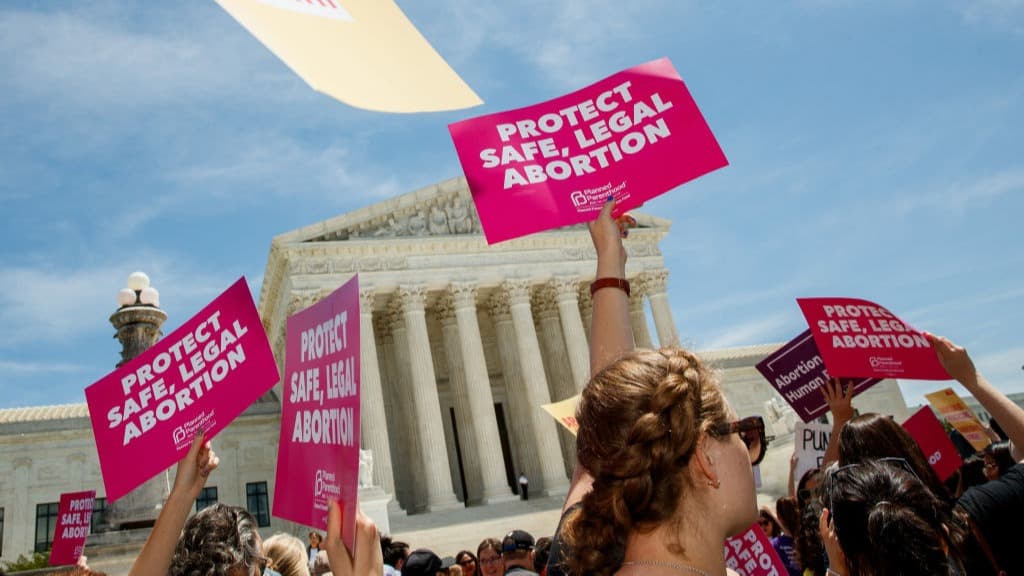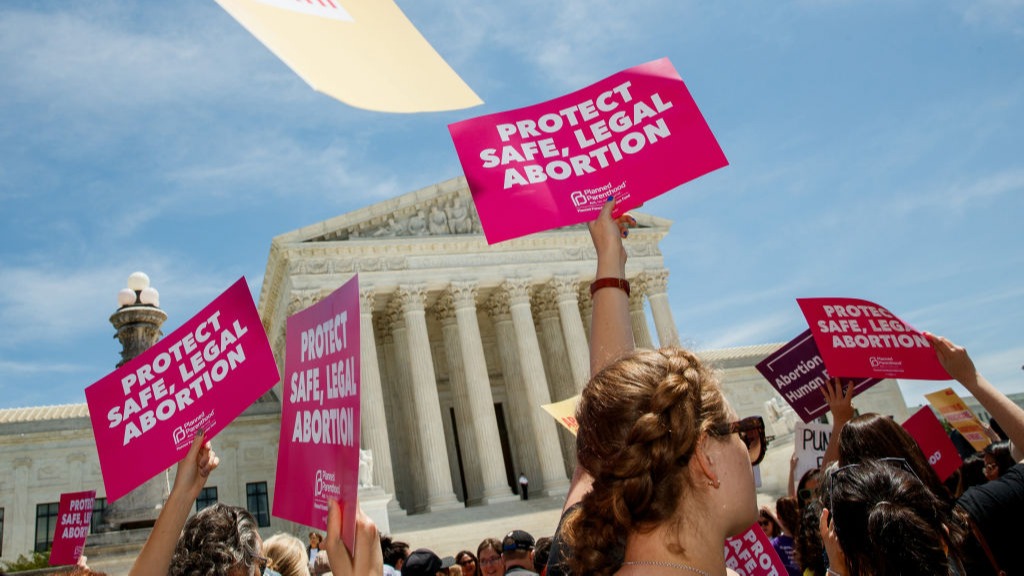Several states have passed restrictive abortion laws this year with a specific goal in mind: get the Supreme Court to reconsider Roe v Wade.

The Story
Abortion is one of the most divisive political issues in the US.
The Background
In 1973, the Supreme Court ruled in the landmark Roe v Wade decision that women have a constitutional right to an abortion. Before that, abortion was mostly illegal, although women still got them.
How?
Not easily. It was often dangerous, expensive, and required women to travel far. In some cases, women tried to induce an abortion on themselves, by using coat hangers, throwing themselves down the stairs, or consuming poison. At least one physician operated undercover – and ended up getting arrested. It was possible, but difficult, to get an abortion safely: a 1966 story in The Washington Post quoted a doctor saying a woman could usually have a safe abortion in a hospital if psychiatrists attested that the patient was suicidal.
Wow. So how did Roe v Wade come about?
In 1969, a Texas woman named Norma McCorvey (known as Jane Roe in later court documents) became pregnant and wanted an abortion. But Texas law only allowed abortion if the mother’s life was at risk. So McCorvey sued the Dallas County district attorney, Henry Wade. The case made it all the way to the Supreme Court, which ruled 7-2 that the constitutional right to privacy protects a woman’s right to an abortion.
What happened next?
The ruling left a lot of the specifics up to the states, which have since passed laws that outline very different ways of handling abortion. Like requiring a minor to get a parent to sign off, requiring patients to get an ultrasound before having an abortion, or banning late-term (after about 24 weeks) abortions.
How common are abortions?
Not as common as they used to be. Research by a group that supports legal abortions shows that the abortion rate has been going down for decades. In 1980, there were 29.3 abortions for every 1,000 women ages 15-44. In 2017, that number fell to about 13.5. There are different theories about why this is happening – like increased access to contraception, fewer people getting pregnant to begin with, and infertility.
The Big Issue
Decades after Roe v Wade passed, there’s an escalating push to get the Supreme Court to revisit the issue.
Why now?
Since President Trump took office, he’s overhauled the nation’s courts by appointing dozens of conservative judges, including two to the highest court there is: the Supreme Court. That’s led to a push by red states to pass restrictive abortion laws that lawmakers know will be challenged in court. The goal: bring this fight to the Supremes at a time when the court has a conservative majority, and may be more likely to overturn Roe v Wade.
Where do things stand?
Nine states passed restrictive abortion bills this year. Most of those were so-called “heartbeat” bans – banning abortion once a fetal heartbeat is detected, typically around six weeks. These bills are controversial because many women don’t realize they’re pregnant at six weeks. But Alabama went the furthest, banning abortion in nearly all cases. The law made no exceptions for rape or incest and doctors could get up to 99 years of jail time if convicted of performing an abortion. State officials explicitly said that the law was drawn up as a challenge to Roe v Wade.
Are these laws in effect?
No. After legal challenges, all of them are on hold while they make their way through the court system.
So it’s happening, SCOTUS is weighing in?
On these particular cases, no. At least not yet. But the Supremes did agree to hear a different abortion case this term. It’s the first abortion case the court will hear since Justice Brett Kavanaugh’s confirmation tilted the bench solidly right. They’re going to hear arguments on a Louisiana law that requires doctors who perform abortions to have admitting privileges at a local hospital. Meaning they have permission to admit a patient to the hospital and provide certain care there.
Skimm More: Skimm Notes explains Kavanaugh’s background and career in law.
What are the arguments?
Supporters of the law say it helps protect women’s health, because doctors with admitting privileges have to meet certain requirements. Critics say it would force nearly every abortion clinic in the state to close, since many providers don’t have admitting privileges. And that women can still get medical attention at hospitals even if their abortion provider doesn’t have those privileges.
What’s going to happen?
We likely won’t find out until the end of the term next summer. But SCOTUS ruled against a nearly identical Texas law in 2016. And some say the court would only take up the issue again if it had something new to say about it. Until then, some states are pushing to solidify their own abortion laws in the event that the federal law changes.
What do you mean?
While some states are passing bills to outlaw abortion early in a pregnancy, other states are working to protect late-term abortions. Earlier this year, New York passed a law that allows abortions past 24 weeks if the woman’s life is at risk or the fetus isn’t viable. Several other states have been considering similar laws, while some congressional lawmakers and President Trump have been pushing bills that would restrict late-term abortions. Late-term abortions are very rare.
The Debate

The Impact
On 2020...special interest groups on both sides of the issue are shelling out a lot of money on advocacy campaigns ahead of the 2020 election. Presidents have the power to nominate federal judges, the Senate decides whether to confirm them. Plus if the Supreme Court does take on Roe v Wade, depending on how it rules it may give state lawmakers more power to regulate abortion. Bottom line: everyone wants the White House, Congress, and local politicians on their side of the issue. And for some voters, it could be the driving force pushing them to the polls.
On access...right now, every state in the country has at least one abortion clinic. Regardless of whether and how the Supreme Court weighs in on this issue, some of these clinics are already in jeopardy. One high profile case comes from Missouri, where health officials are trying to shut down the last clinic in the state. Skimm Notes explains what’s happening there. You'll learn:
✷ How Missouri got into this situation
✷ Why Missouri's last clinic could lose its license
✷ How the Supreme Court fits into the picture
Meanwhile, if Roe v Wade were overturned, abortion policy would fall to states. Some states have trigger laws that would automatically outlaw abortion. Legal abortion rates would likely fall in some parts of the country. Poor people would be most affected, since the majority of people who get abortions are low-income and can’t afford to travel as far for the procedure.
On women...Roe v Wade solidified a woman’s legal right to make decisions about her own body. And there’s evidence that the law improved health outcomes. Before Roe v Wade, research shows that around 17% of pregnancy-related deaths were the result of an illegal abortion. Today, it’s rare that women who get legal abortions experience serious complications. New options like pills that induce an abortion have made the procedure safer. Meanwhile, the Supreme Court pointed out in the ‘90s that as women gained more reproductive freedom, they were able to participate equally in the economy.
theSkimm
Abortion is a complex issue that encompasses debates around privacy, women’s rights, and the role of government, as well as difficult questions about when life begins. For many Americans, it’s not as black and white as politics increasingly makes it out to be.
Live Smarter
Sign up for the Daily Skimm email newsletter. Delivered to your inbox every morning and prepares you for your day in minutes.
